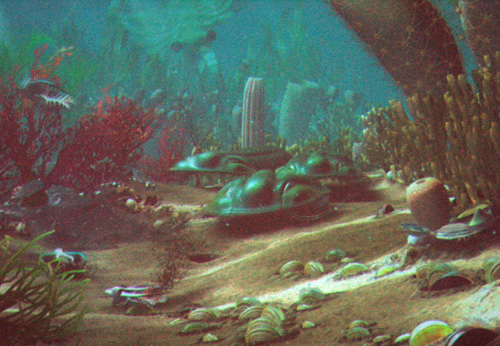Cambrian Period, 543mya to 488.3mya |
||
This was a relatively warm period of about 54.7 million years that followed the much colder Edicaran portion of the late Proterozoic and preceded the Ordovician Period. The Cambrian began around 543 million years before present, and ended around 500 to 490 million years before present (some date it precisely to 488.3 million years ago) as the supercontinent Gondwanaland moved toward the south poll and the Ordovician came with an ice age a mass extinction of warm water species. Geological time scales are divided into great eras. We live in the Cenozoic, and the Mesozoic era is famous for its dinosaurs. Before the Mesozoic we have a period called the Paleozoic Era, which begins with the Cambrian Period. Before the Paleozoic was an era called the Neoproterozoic Era (or the Vendian era, as it is sometimes called). During the Neoproterozoic era there were at least three periods when glaciers were formed so extensively that there is evidence of them near the equator during worldwide ice ages, and some of these ice ages may have lasted for millions or even tens of millions of years. The Cambrian, in contrast, begins a warmer period when life radiated and flourished. The Cambrian Period is famous for the fossil evidence of great radiation in evolution. This great increase in the diversity of life is called the Cambrian explosion. The Burgess Shale fossil beds of the Canadian Rocky Mountains offer exquisite fossils of shallow sea communities from about 515-505 million years ago, and the Maotianshan Shales of China offer fine fossils from about 525-520 million years ago. From these fossils, paleontologists have the idea that the Cambrian Period was the time when vertebrates first evolved (although the first ones had no internal skeletons or spines, just stiff notochords). Also appearing in the fossil record during the Cambrian are the molluscs (actually around 535 million years ago, just before the Cambrian), trilobites (around 521 million years ago), and hyolithids (a sort of creature that may have been a mollusc or closely related to molluscs). One taxonic group of cup-shaped sponges with hundreds of different species (actually, 120 families in the Lower Cambrian) was the Archaeocyatha: these dominated the Cambrian seas and built up massive reefs from about 530 million years ago until about 515 million years ago, by which time they were nearly extinct; none of these sponges seem to have survived into periods after the Cambrian. Later in the Cambrian, there were a couple great extinctions, including one at about 517 million years ago (the Botomian Extinction Event) and another at 502 million years ago (the Dresbachian event). The Cambrian Period closed with the Cambrian-Ordovician extinction event, possibly caused by or coincident with an ice age, as well as depletion of oxygen in the ocean. As the Cambrian Period began, there was one major world continent we call Rodinia, but over the fifty million years of this period, that continent broke up and drifted into smaller land masses, although one major remnant of Rodinia that included Africa, Australia, Antarctica, South America, and much of Asia and the Middle East remained united as Gondwanaland. The land was barren; no plants had evolved. Life in the seas included jawless vertebrates (things that looked like worms or sea squirts were evolving into primitive fish… even today the larval sea squirts resemble frog tadpoles). Pikaia (a primitive Cephalochordate related to modern lancelets) thrived in the Cambrian era. |
|
|
Links about The Cambrian Period
|
 |
|||
| The Cambrian seabed around 505 million years ago from the Field Museum's virtual reality Cambrian aquarium experience. | |||
| Back to the World History Timeline in English | |||
|